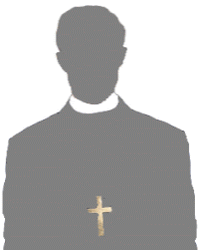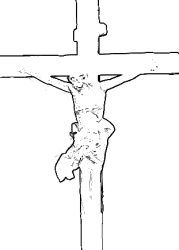Roman Catholic
St Sigismund parish
05-507 Słomczyn
85 Wiślana Str.
Konstancin deanery
Warsaw archdiocese, Poland
full list:
displayClick to display full list

searchClick to search full list by categories
wyświetlKliknij by wyświetlić pełną listę po polsku

szukajKliknij by przeszukać listę wg kategorii po polsku

Martyrology of the clergy — Poland
XX century (1914 – 1989)
personal data

surname
CZERWIAKOWSKI
forename(s)
Sergius (pl. Sergiusz)

function
presbiter (i.e. iereus)
creed
Eastern Orthodox Church ORmore on
en.wikipedia.org
[access: 2014.09.21]
diocese / province
Sankt Petersburg ‐ Gdov OR eparchymore on
ru.wikipedia.org
[access: 2023.07.16]
Sankt Petersburg OR eparchymore on
ru.wikipedia.org
[access: 2023.07.16]
Chelm OR eparchymore on
pl.wikipedia.org
[access: 2020.09.24]
date and place
of death
12.11.1937

Sankt Petersburgtoday: Saint Petersburg city, Russia
more on
en.wikipedia.org
[access: 2020.07.31]
details of death
From 21.02.1914, chaplain of the 21st Murom Infantry Regiment (as part of the 1st Infantry Brigade, 6th Infantry Division, 15th Army Corps) of the Imperial Russian Army, then stationed in Różan.
After the outbreak of World War I in 06.1914, participated in the clashes between the Russian army and the German army: near Orłowo (23.08.1914), Mielno (28.08.1914), as part of the Battle of Tannenberg, which ended around 30.08.1914, in which the Russians were soundly defeated.
His unit was surrounded. Himself was shell–shocked by the explosions of German mortars. On 31.08.1914 taken prisoner.
Held in 5 different POW camps where ministered as a chaplain. Released on 09.08.1918, after the separatist Bolshevik–German–Austrian treaty of 03.03.1918 in Brest–Litovsk, but before the end of World War I.
In view of the escape of most Russians from the occupied Polish territories in 1915 (the so‐called bezhenstvo) — also from his homeland — settled in Sankt Petersburg.
On 31.08.1937, arrested by agents of the genocidal Russian NKVD organization in Tyarlevo, where ministered.
Accused of „participating and leading an anti–Russian counter–revolutionary group”.
On 04.11.1937, in the so‐called „trial of protoiereus Czerwiakowski and others”, sentenced by the genocidal Russian hood court «NKVD Troika» for the Sankt Petersburg district to death.
Murdered prob. in prison.
His wife, after her husband's arrest, was sent to the town of Vyshny Volochyok.
cause of death
mass murder
perpetrators
Russians
sites and events
11.08.1937 Russian genocideClick to display the description, Great Purge 1937Click to display the description
date and place
of birth
19.04.1889

Zabłudówtoday: Zabłudów gm., Białystok pov., Podlaskie voiv., Poland
more on
en.wikipedia.org
[access: 2021.07.18]
alt. dates and places
of birth
13.03.1889
Mokretoday: Bielsk Podlaski gm., Bielsk Podlaski pov., Podlaskie voiv., Poland
more on
en.wikipedia.org
[access: 2023.08.19]
presbyter (holy orders)
ordination
1914

positions held
17.04.1920 – 31.08.1937
parish priest — Tyarlevotoday: Pushkin city reg., Saint Petersburg city, Russia
more on
en.wikipedia.org
[access: 2023.08.19] ⋄ Transfiguration of the Lord OR church — according to some sources from c. 16.08.1923
1919
protoiereus (Eng. first priest) — Russian Orthodox Church — dignity conferment
21.11.1918 – 17.04.1920
rector — Detskoye Seloform.: Tsarskoye Selo
today: Pushkin, Pushkin city reg., Saint Petersburg city, Russia
more on
en.wikipedia.org
[access: 2023.08.19] ⋄ Community of Sisters of Mercy of the Russian Red Cross Society ⋄ „Joy of All Afflicted” Icon of the Mother of God OR church — according to some sources until 16.08.1923 and the closure of the church by the Bolsheviks; on 11.03.1919 awarded, for service during World War I, with a kalimavkion, i.e. a special clerical headdress, and a nabedrennik, i.e. a rectangular scarf symbolizing a spiritual sword; on 30.09.1919 awarded with a pectoral cross, a decorative cross worn on the chest
21.02.1914 – 31.08.1914
chaplain — Imperial Russian Army — till taken prisoner by the Germans; in POW camps till 18.09.1918
1914
presbiter (Eng. priest, i.e. iereus) — Russian Orthodox Church — priesthood cheirotonia, i.e. ordination
from 1914
married — at least one son
13.06.1913 – 1914
missionary — Russian Orthodox Church ⋄ Chełm OR eparchy
till 1913
student — Chełmtoday: Chełm city pov., Lublin voiv., Poland
more on
en.wikipedia.org
[access: 2021.08.20] ⋄ philosophy and theology, Orthodox Theological Seminary
sites and events
descriptions
11.08.1937 Russian genocide: On 11.08.1937 Russian leader Stalin decided and NKVD head, Nicholas Jeżow, signed a «Polish operation» executive order no 00485. 139,835 Poles living in Russia were thus sentenced summarily to death. According to the records of the „Memorial” International Association for Historical, Educational, Charitable and Defense of Human Rights (Rus. Международное историко‐просветительское, правозащитное и благотворительное общество „Мемориал”), specialising with historical research and promoting knowledge about the victims of Russian repressions — 111,091 were murdered. 28,744 were sentenced to deportation to concentration camps in Gulag. Altogether however more than 100,000 Poles were deported, mainly to Kazakhstan, Siberia, Kharkov and Dniepropetrovsk. According to some historians, the number of victims should be multiplied by at least two, because not only the named persons were murdered, but entire Polish families (the mere suspicion of Polish nationality was sufficient). Taking into account the fact that the given number does not include the genocide in eastern Russia (Siberia), the number of victims may be as high as 500,000 Poles. (more on: en.wikipedia.orgClick to attempt to display webpage
[access: 2016.03.14])
Great Purge 1937: „Great Terror” (also «Great Purge», also called „Yezhovshchyna” after the name of the then head of the NKVD) — a Russian state action of political terror, planned and directed against millions of innocent victims — national minorities, wealthier peasants (kulaks), people considered opponents political, army officers, the greatest intensity of which took place from 09.1936 to 08.1938. It reached its peak starting in the summer of 1937, when Art. 58‐14 of the Penal Code about „counter‐revolutionary sabotage” was passed , which became the basis for the „legalization” of murders, and on 02.07.1937 when the highest authorities of Russia, under the leadership of Joseph Stalin, issued a decree on the initiation of action against the kulaks. Next a number of executive orders of the NKVD followed, including No. 00439 of 25.07.1937, starting the liquidation of 25,000‐42,000 Germans living in Russia (mainly the so‐called Volga Germans); No. 00447 of 30.07.1937, beginning the liquidation of „anti‐Russian elements”, and No. 00485[2] of 11.08.1937, ordering the murder of 139,835 people of Polish nationality (the latter was the largest operation of this type — encompassed 12.5% of all those murdered during the «Great Purge», while Poles constituted 0.4% of the population). In the summer of 1937 Polish Catholic priests held in Solovetsky Islands, Anzer Island and ITL BelbaltLag were locked in prison cells (some in Sankt Petersburg). Next in a few kangaroo, murderous Russian trials (on 09.10.1937, 25.11.1937, among others) run by so‐called «NKVD Troika» all were sentenced to death. They were subsequently executed by a single shot to the back of the head. The murders took place either in Sankt Petersburg prison or directly in places of mass murder, e.g. Sandarmokh or Levashov Wilderness, where their bodies were dumped into the ditches. Other priests were arrested in the places they still ministered in and next murdered in local NKVD headquarters (e.g. in Minsk in Belarus), after equally genocidal trials run by aforementioned «NKVD Troika» kangaroo courts.
sources
personal:
ru.openlist.wikiClick to attempt to display webpage
[access: 2023.08.19], kuz1.pstbi.ccas.ruClick to attempt to display webpage
[access: 2023.08.19], konstantinpalace.ruClick to attempt to display webpage
[access: 2023.08.19]
bibliographical:
„Hierachy, clergy and employees of the Orthodox Church in the 19th‐21st centuries within the borders of the Second Polish Republic and post–war Poland”, Fr Gregory Sosna, M. Antonine Troc-Sosna, Warsaw–Bielsk Podlaski 2017
LETTER to CUSTODIAN/ADMINISTRATOR
If you have an Email client on your communicator/computer — such as Mozilla Thunderbird, Windows Mail or Microsoft Outlook, described at WikipediaPatrz:
en.wikipedia.org, among others — try the link below, please:
LETTER to CUSTODIAN/ADMINISTRATORClick and try to call your own Email client
If however you do not run such a client or the above link is not active please send an email to the Custodian/Administrator using your account — in your customary email/correspondence engine — at the following address:

giving the following as the subject:
MARTYROLOGY: CZERWIAKOWSKI Sergius
To return to the biography press below:
 Click to return to biography
Click to return to biography







